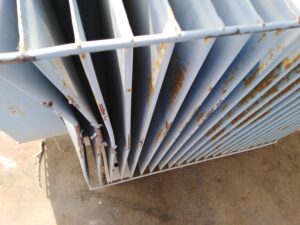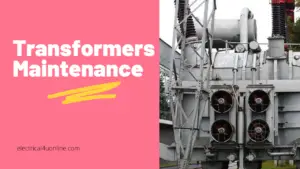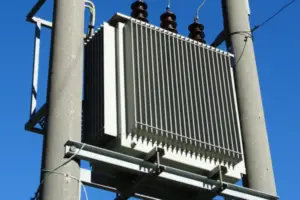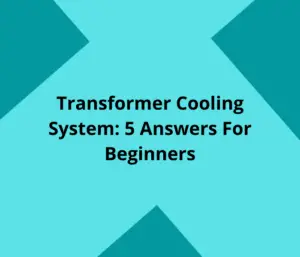Transformers are vital components of the electrical power system. They convert high voltage low current AC power to low voltage high current AC power and vice versa.
ONAN transformers are one such type of transformer that is widely used in power distribution systems.
In this article, we will discuss ONAN transformers in detail, including their working principle, advantages, disadvantages, maintenance, common issues, differences with ONAF transformers, and types of cooling systems used in ONAN transformers.
Table of Contents
What is an ONAN transformer?
ONAN stands for Oil Natural Air Natural. It is a type of transformer that uses oil as a coolant and natural air as a cooling medium.
ONAN transformers are typically used in power distribution systems where the power rating is up to 10 MVA.
They are generally installed outdoors, and the natural cooling system makes them highly reliable and cost-effective.
Working principle of an ONAN transformer
The working principle of an ONAN transformer is simple. It uses oil as a coolant, which circulates through the transformer coils and core.
The oil carries away the heat generated due to transformer losses and transfers it to the transformer tank.
The transformer tank has cooling fins that increase the surface area of the tank and allow the heat to dissipate into the surrounding air.
The natural air circulation around the transformer tank helps to remove the heat from the tank and keep the transformer cool.
The cooling fans are not required in ONAN transformers, making them less expensive and less complex than other types of transformers.
Advantages of using an ONAN transformer
- Highly reliable: ONAN transformers are highly reliable as they use natural air and oil cooling systems, which are less complex and more reliable than forced air cooling systems.
- Low maintenance: The natural cooling system in ONAN transformers requires very little maintenance, reducing the maintenance costs significantly.
- Long lifespan: ONAN transformers have a long lifespan and can last up to 30 years or more with proper maintenance.
- Cost-effective: ONAN transformers are cost-effective due to their simple design, low maintenance, and long lifespan.
Disadvantages of using an ONAN transformer
- Limited power rating: ONAN transformers are suitable for power ratings up to 10 MVA. For higher power ratings, other types of transformers such as ONAF or OFAF transformers may be required.
- Ambient temperature: The performance of ONAN transformers is affected by the ambient temperature. In extreme weather conditions, the transformer may require additional cooling or heating systems to maintain its efficiency. Read my in-deptharticle about Keeping Transformer Safe in High Ambient Temperature.
Maintaining an ONAN transformer

To ensure the longevity and efficiency of an ONAN transformer, regular maintenance is essential. Some of the maintenance activities include:
- Checking the oil level and quality regularly
- Inspecting the cooling fins and cleaning them if necessary
- Testing the insulation resistance
- Checking the tightness of connections
- Performing regular oil filtration and replacement
For more information about Transformer Maintenance, read my article here.
Common issues with ONAN transformers and their solutions
Some common issues or problems that can occur with ONAN transformers include:
- Oil leaks
- Overheating
- Moisture in the oil
- Corrosion
These issues can be addressed by:
- Regular inspection and maintenance
- Proper sealing of the transformer tank
- Installing a dehumidifier to remove moisture
Differences between ONAN and ONAF transformers
ONAF stands for Oil Natural Air Forced. It is a type of transformer that uses oil as a coolant and forced air as a cooling medium.
Unlike ONAN transformers, ONAF transformers require cooling fans to circulate air around the transformer tank.
The forced air cooling system makes ONAF transformers suitable for higher power ratings and extreme weather conditions. However, they are more complex and expensive than ONAN transformers.
The following table summarizes the differences between ONAN and ONAF transformers:
| Parameter | ONAN Transformer | ONAF Transformer |
|---|---|---|
| Cooling medium | Natural air | Forced air |
| Cooling system | Natural | Forced |
| Cooling fans | Not required | Required |
| Suitable power rating | Up to 10 MVA | Higher than 10 MVA |
| Reliability | High | Medium to high |
| Complexity | Low | High |
| Cost | Low | High |
Types of cooling systems used in ONAN transformers
There are two types of cooling systems used in ONAN transformers: self-cooled and water-cooled.
In self-cooled ONAN transformers, the natural air circulation around the transformer tank is sufficient to dissipate the heat generated.
In water-cooled ONAN transformers, water is used as a coolant instead of air. Water-cooled ONAN transformers are suitable for locations where the ambient temperature is very high.
The choice of cooling system depends on the power rating of the transformer and the ambient temperature.
The following table summarizes the different types of cooling systems used in ONAN transformers and their effects:
| Cooling System | Effect |
|---|---|
| Self-cooled | Suitable for low to medium power ratings |
| Water-cooled | Suitable for high power ratings and high ambient temperatures |
Conclusion
ONAN transformers are an essential component of the power distribution system. They are highly reliable, cost-effective, and require low maintenance.
However, they have a limited power rating and are affected by extreme weather conditions. To ensure the longevity and efficiency of an ONAN transformer, regular maintenance is essential.
The choice of cooling system depends on the power rating of the transformer and the ambient temperature.
Don’t Leave Empty-Handed!
Install my Free Android App on Google Play:
Electrical Cables Most Common Tables “Cables Tables”
And, my Electrical Calculations App “Fast Electrical Calculator”
Discover more great content by subscribing to My channel
Looking to stay ahead of the game in the world of electrical engineering? Subscribe to my YouTube channel and gain access to exclusive content you won’t find anywhere else!
The staff I recommend
(Amazon Affiliate Links to products I believe are high quality):
- Economy 120 Volt/60Hz AC Power Source – Step-Down Voltage & Frequency Converters 1800W
- UNI-T Digital Multimeter Tester UT139C
- 50-Amp Extension Cord for RV “100ft”
- Voltage Stabilizer 110/220v
- Hair Dryer “best selling“
- TOSHIBA EM131A5C-BS Countertop Microwave Ovens
Disclaimer: This contains affiliate links to Amazon products. I may earn a commission for purchases made through these links.




